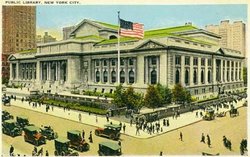New York Public Library
|
|
Nyc-nypl.jpg
The New York Public Library (NYPL), one of three public library systems serving New York City, is one of the leading libraries in the United States. Its main building on Fifth Avenue (illustration, right) is the crowning achievement of the Beaux-Arts architectural firm of Carrere and Hastings. Its status as one of the world's leading libraries is confirmed by its possession of (for instance) a Gutenberg Bible and a Philosophiae Naturalis Principia Mathematica.
| Contents |
History
New_york_public_library_1948.jpg
In the late nineteenth century, New York City had two reference libraries open to the public: the Astor Library, founded by a $400,000 bequest of John Jacob Astor (1763–1848), which had opened in 1849, and the Lenox Library, founded by James Lenox (1800–1880), a book collector, which stood on the Fifth Avenue site now occupied by the Frick Collection.
In 1886, Samuel J. Tilden (1814–1886) made a bequest of about $2.4 million to establish a library in New York City.

John Bigelow (1817–1911), a New York attorney, was a trustee of the Tilden will, and formulated a plan to combine the resources of the financially-strapped Astor and Lenox libraries with the Tilden bequest to form "The New York Public Library, Astor, Lenox and Tilden Foundations". This entity came into being as a private foundation on May 23, 1895.
The library consolidated with The New York Free Circulating Library in February, 1901, and Andrew Carnegie donated $5.2 million to construct branch libraries, with the proviso that the City of New York fund their maintenance and operations. The New York Public Library is thus a partnership of city government with private philanthropy, characteristic of the American way.
NYCPubLibRsrchRmMed.JPG
The main Research Library was built on Fifth Avenue in Manhattan between 40th and 42nd Streets, and was dedicated on May 23, 1911, opening the next day. The famous lions guarding the entrance were sculpted by Edward Clark Potter. They were originally named Leo Astor and Leo Lenox, in honor of the library's founders. These names were transformed into Lord Astor and Lady Lenox (although both lions are male). In the 1930s they were nicknamed "Patience" and "Fortitude" by Mayor Fiorello LaGuardia. He chose these names because he felt that the citizens of New York would need to possess these qualities to see themselves through the Great Depression. Patience is on the south side (the left as one faces the main entrance) and Fortitude on the north.
The main reading room of the Research Library, the famous room 315, is one of the most majestic sights one may see; 78 feet (23.8 m) wide by 297 feet (90.5 m) long, with ceilings 52 feet (15.8 m) high; surrounded by open shelves, both on the main level and the balcony, which contain standard and not so standard reference works of all kinds; tall windows and chandeliers above; long tables with comfortable chairs and brass lamps; computers with access to the library collections and to the internet; docking facilities for laptops; readers comfortably at work with materials from the closed stacks, brought to their seats by the staff on request. All of this, and more, available without charge to anyone. Many notable authors have cited research in this room as seminal in their work. Many others, out of work during the Great Depression, used this resource to give themselves the equivalent of a university education.
In the 1980s the library added more than 125,000 square feet (12,000 m²) of space to its storage capacity. This expansion required a major construction project in which Bryant Park, directly west of the library, was closed to the public and excavated. The new library facilities were built below ground level. The park was then restored on top of the underground facilities and re-opened to the public.
Branches
The NYPL maintains 85 branch libraries throughout The Bronx, Manhattan, and Staten Island. Branch locations offer popular fiction and basic research materials, and NYPL's four specialized Research Libraries offer world-renowned collections on a wide variety of topics. The research libraries include The Humanities and Social Sciences Library, The New York Public Library for the Performing Arts (at Lincoln Center), Schomburg Center for Research in Black Culture, and the Science, Industry and Business Library.
Library in fiction
The NYPL has frequently appeared in feature films, most often as backdrop or a brief meeting place for characters. It serves as the backdrop for a central plot development in the 2002 film Spider-Man and a major location in the 2004 apocalyptic science fiction film The Day After Tomorrow.
It is also featured prominently in the 1984 film Ghostbusters. In the film, a librarian in the basement reported seeing a ghost, which became violent when approached.
See also
- Brooklyn Public Library
- Queens Borough Public Library
- List of museums and cultural institutions in New York City
- NYPL Digital Gallery
External links
- New York Public Library (http://www.nypl.org/)
- NYPL Research Libraries (http://www.nypl.org/research/)
- A link to the General Research Division, with a spectacular photo of room 315 (http://www.nypl.org/research/chss/grd/index.html)he:ספריית העיר ניו יורק
fr:New York Public Library de:New York Public Library ja:ニューヨーク公共図書館
